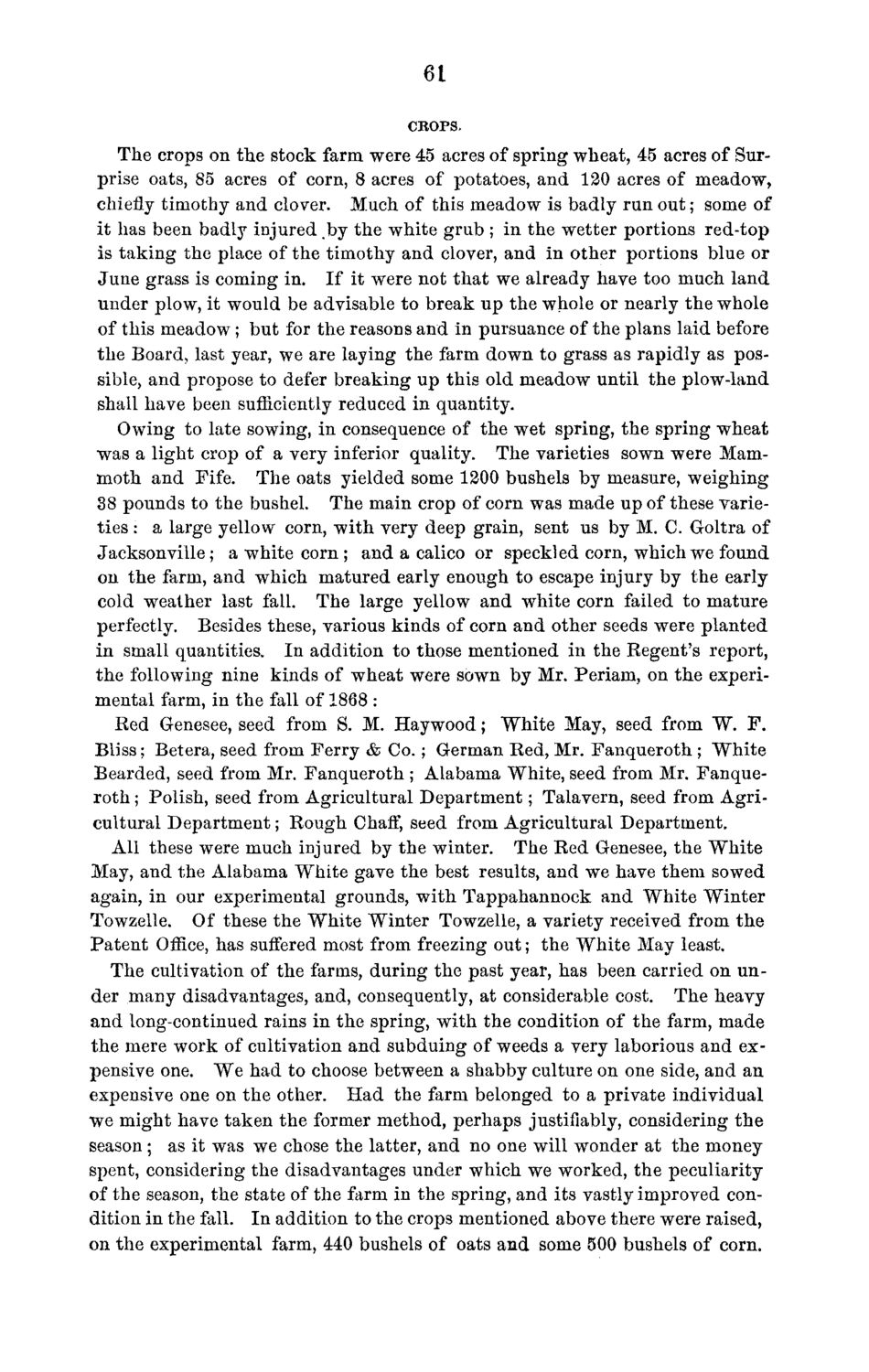| |
| |
Caption: Board of Trustees Minutes - 1870
This is a reduced-resolution page image for fast online browsing.

EXTRACTED TEXT FROM PAGE:
61 CROPS. The crops on the stock farm were 45 acres of spring wheat, 45 acres of Surprise oats, 85 acres of corn, 8 acres of potatoes, and 120 acres of meadow, chiefly timothy and clover. Much of this meadow is badly run o u t ; some of it has been badly injured .by the white grub ; in the wetter portions red-top is t a k i n g the place of the timothy and clover, and in other portions blue or J u n e grass is coming in. If it were not t h a t we already have too much land under plow, it would be advisable to break up the whole or nearly the whole of this meadow; but for the reasons and in pursuance of the plans laid before the Board, last year, we are laying the farm down to grass as rapidly as possible, and propose to defer breaking up this old meadow until the plow-land shall have been sufficiently reduced in quantity. Owing to late sowing, in consequence of the wet spring, the spring wheat was a light crop of a very inferior quality. The varieties sown were Mammoth and Fife. The oats yielded some 1200 bushels by measure, weighing 38 pounds to the bushel. The main crop of corn was made up of these varieties : a large yellow corn, with very deep grain, sent us by M. C. Goltra of Jacksonville; a white corn ; and a calico or speckled corn, which we found on the farm, and which matured early enough to escape injury by the early cold weather last fall. The large yellow and white corn failed to mature perfectly. Besides these, various kinds of corn and other seeds were planted in small quantities. In addition to those mentioned in the Regent's report, the following nine kinds of wheat were sown by Mr. Periam, on the experimental farm, in the fall of 1868 : Red Genesee, seed from S. M. Haywood; White May, seed from W. F . Bliss; Betera, seed from Ferry & Co. ; German Red, Mr. Fanqueroth ; W h i t e Bearded, seed from Mr. Fanqueroth ; Alabama White, seed from Mr. Fanqueroth ; Polish, seed from Agricultural D e p a r t m e n t ; Talavern, seed from Agricultural Department; Rough Chaff, seed from Agricultural Department. All these were much injured by the winter. The Red Genesee, the W h i t e May, and the Alabama White gave the best results, and we have them sowed again, in our experimental grounds, with Tappahannock and White Winter Towzelle. Of these the White Winter Towzelle, a variety received from the P a t e n t Office, has suffered most from freezing out; the W h i t e May least. The cultivation of the farms, during the past year, has been carried on under many disadvantages, and, consequently, at considerable cost. The heavy a n d long-continued rains in the spring, with the condition of the farm, made the mere work of cultivation and subduing of weeds a very laborious and expensive one. We had to choose between a shabby culture on one side, and an expensive one on the other. H a d the farm belonged to a private individual we might have taken the former method, perhaps justifiably, considering t h e season ; as it was we chose the latter, and no one will wonder at the money spent, considering the disadvantages under which we worked, the peculiarity of the season, the state of the farm in the spring, and its vastly improved condition in the fall. In addition to the crops mentioned above there were raised, on the experimental farm, 440 bushels of oats and some 500 bushels of corn.
| |